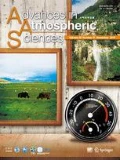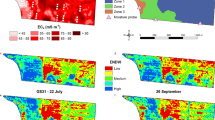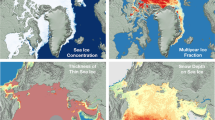Abstract
This study investigates the use of dynamic a priori error information according to atmospheric moistness and the use of quality controls in temperature and water vapor profile retrievals from hyperspectral infrared (IR) sounders. Temperature and water vapor profiles are retrieved from Atmospheric InfraRed Sounder (AIRS) radiance measurements by applying a physical iterative method using regression retrieval as the first guess. Based on the dependency of first-guess errors on the degree of atmospheric moistness, the a priori first-guess errors classified by total precipitable water (TPW) are applied in the AIRS physical retrieval procedure. Compared to the retrieval results from a fixed a priori error, boundary layer moisture retrievals appear to be improved via TPW classification of a priori first-guess errors. Six quality control (QC) tests, which check non-converged or bad retrievals, large residuals, high terrain and desert areas, and large temperature and moisture deviations from the first guess regression retrieval, are also applied in the AIRS physical retrievals. Significantly large errors are found for the retrievals rejected by these six QCs, and the retrieval errors are substantially reduced via QC over land, which suggest the usefulness and high impact of the QCs, especially over land. In conclusion, the use of dynamic a priori error information according to atmospheric moistness, and the use of appropriate QCs dealing with the geographical information and the deviation from the first-guess as well as the conventional inverse performance are suggested to improve temperature and moisture retrievals and their applications.
Similar content being viewed by others
References
Borbas, E. E., S. W. Seemann, A. Kern, L. Moy, J. Li, and L. Gumley, 2011: MODIS atmospheric profile retrieval algorithm theoretical basis document. Version 7, 32pp. [Available online at http://modisatmos.gsfc.nasa.gov/_docs//MOD07_atbd_v7_April2011.pdf]
Carissimo, A., I. De Feis, and C. Serio, 2005: The physical retrieval methodology for IASI: The δ-IASI code. Environmental Modelling and Software, 20, 1111–1126.
Chahine, M. T., and Coauthors, 2006: AIRS: Improving weather forecasting and providing new data on greenhouse gases. Bull. Amer. Meteor. Soc. 87, 911–926.
Crosby, D., and M. Weinreb, 1974: Effect of incorrect atmospheric statistics on the accuracy of temperature profiles derived from satellite measurements. Environmental Modelling and Software, 3, 41–51.
Eyre, J., 1989: Inversion of cloudy satellite sounding radiances by nonlinear optimal estimation. I: Theory and simulation for TOVS. Quart. J. Roy. Meteor. Soc., 115, 1001–1026.
Ho, S.-P., J. Gille, D. Edwards, J. Attie, M. Deeter, J. Warner, G. Francis, and D. Ziskin, 2001: The role of a priori information in the retrieval of CO pro-files from Terra-MOPITT measurements. 11th Conference on Satellite Meteorology and Oceanography, Madison, WI, USA, P5.53.
Jiang, D., C. Dong, P. Zhang, and X. Wu, 2005: Neural networks for atmospheric temperature retrieval from AQUA AIRS/AMSU/HSB measurements. Proc. International TOVS Study Conferences-XIV, Beijing, China, 10pp.
Li, J., 1994: Temperature and water vapor weighting functions from radiative transfer equation with surface emissivity and solar reflectivity. Adv. Atmos. Sci., 11(4), 421–426.
Li, J., W. Wolf, W. Menzel, W. Zhang, H. Huang, and T. Achtor, 2000: Global soundings of the atmosphere from ATOVS measurements: The algorithm and validation. J. Appl. Meteor., 39, 1248–1268.
Li, J., W. P. Menzel, F. Sun, T. J. Schmit, and J. Gurka, 2004: AIRS sub-pixel cloud characterization using MODIS cloud products, J. Appl. Meteorol., 43, 1083–1094.
Li, J., J. Li, E. Weisz, and D. Zhou, 2007: Physical retrieval of surface emissivity spectrum from hyperspectral infrared radiances. Geophys. Res. Lett., 34, L16812, doi: 10.1029/2007GL030543.
Li, Z., 2009: Improvements and applications of atmospheric soundings from geostationary platform. Ph. D. dissertation, University of Wisconsin-Madison, Madison, WI, USA, 134pp.
Loveland, T., B. Reed, J. Brown, D. Ohlen, J. Zhu, L. Yang, and J. Merchant, 2000: Development of a global land cover characteristics database and IGBP DISCover from 1-km AVHRR data. Int. J. Remote Sens., 21, 1303–1330.
Luo, M., and Coauthors, 2007: Comparison of carbon monoxide measurements by TES and MOPITT: In-fluence of a priori data and instrument characteristics on nadir atmospheric species retrievals. J. Geophys. Res., 112, D09303, doi: 10.1029/2006JD007663.
Ma, X., T. Schmit, and W. Smith, 1999: A nonlinear physical retrieval algorithm—Its application to the GOES-8/9 sounder. J. Appl. Meteor., 38, 501–513.
Maddy, E., C. Barnet, M. Goldberg, C. Sweeney, and X. Liu, 2008: CO2 retrievals from the Atmospheric Infrared Sounder: Methodology and validation. J. Geophys. Res., 113, D11301, doi: 10.1029/2007JD009402.
Prunet, P., V. Casse, and J. Thepaut, 2001: Infrared atmospheric sounding interferometer data information content; instrument characterization and the impact of a priori information. Tellus, 53A, 380–402.
Rodgers, C. D., 2000: Inverse Methods for Atmospheric Sounding: Theory and Practice. World Scientific Publishing Co. Ltd., Singapore, 238pp.
Smith, W. L., D. K. Zhou, A. M. Larar, S. A. Mango, H. B. Knuteson, H. E. Revercomb, and W. L. Smith Jr., 2005: The NPOESS Airborne Sounding Testbed Interferometer-Remotely sensed surface and atmospheric conditions during CLAMS. J. Atmos. Sci., 62, 1118–1134.
Strow, L. L., S. E. Hannon, S. De Souza-Machado, H. E. Motteler, and D. Tobin, 2003: An overview of the AIRS Radiative Transfer Model. IEEE Trans. Geosci. Remote Sens., 41, 303–313.
Susskind, J., C. Barnet, and J. Blaisdell, 2003: Retrieval of atmospheric and surface parameters from AIRS/AMSU/HSB data in the presence of clouds. IEEE Trans. Geosci. Remote Sensing, 41(2), 390–409.
Susskind, J., and O. Reale, 2009: Improving forecast skill by assimilation of quality controlled AIRS Version 5 temperature soundings. Proc. SPIE Int. Symp. Infrared Spaceborne Remote Sensing Instrum. XVII, San Diego, CA, USA, SPIE 7453, 74530G, doi: 10.1117/12.831215.
Weisz, E., H. Huang, J. Li, E. Borbas, K. Baggett, P. Thapliyal, and L. Guan, 2007: International MODIS/AIRS processing package: AIRS applications and products. J. Appl. Remote Sens., 1, 013519, doi: 10.1117/1.2766867.
Author information
Authors and Affiliations
Corresponding author
Rights and permissions
About this article
Cite this article
Kwon, EH., Li, J., Li, J. et al. Use of total precipitable water classification of a priori error and quality control in atmospheric temperature and water vapor sounding retrieval. Adv. Atmos. Sci. 29, 263–273 (2012). https://doi.org/10.1007/s00376-011-1119-z
Received:
Revised:
Published:
Issue Date:
DOI: https://doi.org/10.1007/s00376-011-1119-z




